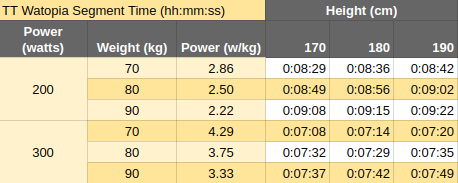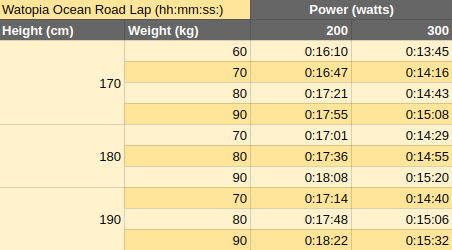In Real Life (IRL) cycling, the laws of physics apply and determine how fast we go. Do the same laws apply on Zwift, so that lighter riders go faster on the climbs on Zwift?
We hear from heavier riders how lighter riders are at an advantage as soon as the road goes up, and viceversa, lighter riders claim they can’t compete with heaver riders on the flats. That would be the case IRL, is it so on Zwift?
A few weeks ago, I set myself to find out how weight and aero (using height by proxy) impact times. This is becoming very important recently as we manage many more group rides at Team WBR and need to provide guidance to keep the group together. It is also good to know for racing and for analyzing digital-doping on weight or height.
I ran the tests using my BLE power meter cycling simulator, which is also what I use to connect the WaterRower S4 to Zwift. I tested on Watopia Flat and Watopia Mountain routes using different weights and heights, and always on a Zwift TT with Zipp 808/Disc wheels (I picked the Zwift TT bike to avoid benefiting from draft during the tests). The theory is that by fixing the bike and the wheels, the height difference here is all that is affecting the aerodynamics.
Absolute Power, Height and Aerodynamics
When we cycle in flat terrain in real life, the aerodynamic drag (air resistance) is what determines how fast the bike travels. Drag is impacted by the rider’s size, position, bike’s design, helmet, etc. Weight however is not a factor impacting pace on the flats, at least once the bike reaches cruising speed.
If IRL would apply to Zwift, we would expect to see:
- Given the same aero configuration, absolute power is the only factor that determines pace, which is independent of the rider’s weight.
- Given the same absolute power and weight, given a bike and wheels kit, pace is only impacted by height.
To figure this out, I setup a virtual rider using the following parameters:
- Height: 170cm, 180cm, 190cm
- Power: 200w, 300w
- Weight: 70kg, 80kg, 90kg
- Bike/Kit: Zwift TT, Zipp 808/Disc
- Route: Watopia Flat
- Strava segment: TT Watopia
The findings, which are shown on the table below, are not quite what I expected:
- There is a 3.5% time penalty per 10kg of weight. At 200w, the heavier 90kg rider (170cm) is 39 sec slower, (7.66%). At 300w, this difference is 6.8%. I expected the rider’s weight not to impact segment times, since this is a flat segment where only aero and absolute power should matter.
- Across the board, there is approximately 5 secs penalty per 10cm of additional height. I expected some impact of height, as the rider will have a harder time getting tucked into a good aero position, but the penalty is more than I thought.
- There is a very strange anomaly here for 300w and 80kg. The 180cm rider is actually faster than the 170cm one, and the 190cm is approximately the same as the 170cm. I ran the tests twice, and the results seem consistent so I am not sure why this is happening.

Dragging Your Weight
And this brings us to the mountain. What happens when we go up? In theory, here weight should be a significant factor. For the same absolute power, the lighter rider should go up faster, since it generates more watts per kilogram. That is the case in Zwift, but by how much?
I wanted to find out the impact of weight:
- Given the same absolute power and aero configuration, the lighter rider generates more watts per kg and is therefore faster. By how much?
- Given the same weight and aero configuration, the rider with more power is faster. By how much?
I used the same settings as in the aero test to do a few laps of Watopia Flat. The results for the Watopia Ocean Road Lap Strava segment, which are also available on the table below, are very interesting to understand how Zwift’s algorithms work:
- There is a 3% time penalty per 10kg of weight, given the same aero (height) and power. For 200w, this is about 3.3% and for 300w it goes down to 2.9%.
- There is a 15% time improvement per additional 100w of power, given the same aero (height) and weight. This is consistent for all height and weight levels.

During these tests I came across something very intriguing that would make me do further tests: at the same watts/kg (3.33 w/kg) and height (170cm), the heavier rider was 30 seconds faster per Watopia Ocean Road lap! Really? Why?
Going Up, Up, Up
As this was very puzzling to me, I wanted to see what would happen on a longer climb given the same relative watts per kg, but for heavier and lighter riders. This time I setup the virtual rider to go around the Watopia Mountain route, to look at the climb on the long EPIC KOM. This time I used the following parameters for the tests:
- Height: 180cm
- Power (relative): 3.33 w/kg
- Power (absolute): 233w (70kg), 266w (80kg), 300w (90kg)
- Weight: 70kg, 80kg, 90kg
- Bike/Kit: Zwift TT, Zipp 808/Disc
- Route: Watopia Mountain
- Strava segment: EPIC KOM
The results are non-obvious to me:
- The 80kg rider is 1.1% faster than the 70kg rider.
- The 90kg rider is 1.8% faster than the 80kg rider (2.9% faster than the 70kg rider). Remember that the 90kg rider is putting 300w to go up, whereas the 70kg rider only needs 233w. So, the finding here is that if you can support it with absolute power numbers, it’s better to be big, rather than small, on the Zwift KOMs.

Going Fast on the Descent
What goes up, must go down, right? Ok, so how fast do we go down? Again, same test parameters as with the ascent test. The results are even more intriguing (for the Mountain Descent Strava segment):
- The 70kg and 80kg riders are equally fast. This is good, since in theory we set the same aero drag by fixing bike/kit and height.
- The 90kg rider is 2.9% faster than the 80kg one. Why?

Summary
This has been a long post, but there are some important points I think here, at least for us at Team WBR leading group rides:
- At a set w/kg, all other things being equal, the heavier rider is always at an advantage (i.e. the lighter riders don’t have it easier). This is specially true as the road goes up, but also applies to descents and event flats.
- In a dead flat road, weight still has a significant impact, and w / kg is still the only proper way to set a target, not watts.
- Height affects your CdA significantly. 10cm extra will set you back 30 secs in Watopia Flat.
When setting a target for a group ride that encourages keeping the group together, the most effective metric is watts / kg, not watts or speed.
blog comments powered by Disqus